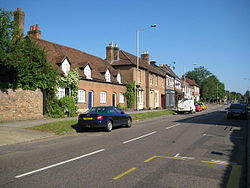Kings Langley
| Kings Langley | |
| Hertfordshire | |
|---|---|
 Kings Langley High Street, looking north. | |
| Location | |
| Grid reference: | TL067030 |
| Location: | 51°42’56"N, 0°27’25"W |
| Data | |
| Population: | 5,072 (2001) |
| Post town: | Kings Langley |
| Postcode: | WD4 |
| Dialling code: | 01923 |
| Local Government | |
| Council: | Dacorum |
| Parliamentary constituency: |
Hemel Hempstead |
Kings Langley is a village in Hertfordshire on the southern edge of the Chiltern Hills and now considered part of the London commuter belt. It was once the location of Kings Langley Palace, a Royal palace of the Plantagenet kings of England. The twelfth century parish church of All Saints houses the tomb of the first Duke of York.
Kings Langley is 2 miles south of Hemel Hempstead and 2 miles north of Watford, as yet escaping the unwanted attentions of each.
History
A Roman villa has been excavated just south of the village.[1]
The village was probably part of the lands of the Abbey of St Albans, although actual records have been lost. At the Norman conquest the manor was given to William's half brother Robert, Count of Mortain who let it to one Ralf. It is around the manor that the present village developed as a linear village lying on the old road from London to Berkhamsted and the Midlands.[2]
Around 1276 the manor was purchased by Queen Eleanor[3] and a palace was built on the hill above the village to its west with a deer park extending to its south.[4] This gave the village its link to royalty, first being renamed Langley Regina ("Queen's Langley") after its sponsoring queen, making the distinction from the manor of Abbots Langley. After Queen Eleanor's time, the manor and village became "Kings Langley".[4] The village remained the location of Kings Langley Palace, a Royal palace of the Plantagenet kings of England:[3] a priory was founded next to the palace and remains of this can still be seen.[2] The palace and the grand church that accompanied the priory fell into disrepair at the Dissolution of the monasteries and little remains above ground level.[4]
The church of All Saints was built during the 14th century on the site of an earlier church. The body of King Richard II was buried here for a time after his probable murder at Pontefract Castle in 1400. It was later removed to Westminster Abbey. The body of Edmund of Langley, died 1402, the fifth son of King Edward III and the first Duke of York, still rests in the memorial chapel.[2][5]

The eighteenth century Sparrows Herne turnpike road (later the A41 trunk road) traversed the Chilterns by way of the valley of the River Gade and ran down the village high street. The 16th century Saracens Head public house is a coaching inn which flourished in this period.
The village was connected by a canal opened in 1797, now part of the Grand Union Canal and in 1838 by the London and Birmingham Railway which later became the West Coast Main Line, (the main railway line from London to the north west). The roailway passes just east of the village at Kings Langley railway station.
Twentieth century housing developments have led to the village spreading out on either side of the main road. The A41 has now been diverted west of the village leaving the high street to local traffic for the first time in centuries.
The London orbital motorway, the M25, passes just south of the village (Junction 20) on an imposing viaduct across the River Gade valley.
Kings Langley was the home of the makers of Ovaltine and the listed factory facade is now all that is left and still stands alongside the railway line among a new housing development. The Ovaltine factory itself has recently been converted into a series of flats and duplexes. The former Ovaltine Egg Farm was converted into energy-efficient offices which house Renewable Energy Systems. The complex incorporates a highly visible 225 kW[6] wind turbine alongside the M25.
Kings Langley is home to a Waldorf School, the Rudolf Steiner School Kings Langley. This is built on the grounds of the old palace, of which only a small basement part of a pillar remains to be seen. There is also a small display cabinet of finds from the palace period in the school entrance foyer.[5]
Mentions in literature
- William Shakespeare's Richard II, Act IV, Scene I (1595) is set in the garden of the palace at Langley.
- Emily Sarah Holt's novel The White Rose of Langley (1875) has many scenes in the palace. (Download available at Project Gutenberg)
Notes
- ↑ Site of Kings Langley Roman Villa at Online Archaeology - UK Archaeology Resource. accessed 5 April 2010
- ↑ 2.0 2.1 2.2 Lionel M, Munby, The History of Kings Langley
- ↑ 3.0 3.1 British History On-line
- ↑ 4.0 4.1 4.2 Hertfordshire Federation of Women's Institutes; Ann Roxburgh (Forward) (1986). The Hertfordshire Village Book. Countyside Books. ISBN 090539271X.
- ↑ 5.0 5.1 Kings Langley Local History and Museum Society
- ↑ "Power from the wind" (PDF). Renewable Energy Systems. http://www.beaufortcourt.com/pdf/BeaufortCourt/WindPower1.pdf. Retrieved 2008-11-16.
References
- Munby (ed), Lionel M.; Various. The History of Kings Langley. Kings Langley branch of the Workers' Educational Association.
- Hastie, Scott; Spain, David (photographs) (1991). Kings Langley, A Hertfordshire Village. Kings Langley: Alpine Press Ltd. ISBN 095076471X.
- Hastie, Scott; Spain, David (photographs). A Hertfordshire Valley. Kings Langley: Alpine Press Ltd. ISBN 0-9528631-0-3.
- Kings Langley, its history and local architecture Kings Langley Local History and Museum Society. Accessed January 2008
- Kings langley Roman Villa at UK Archaeology Map. Accessed January 2008
- Hertfordshire Federation of Women's Institutes; Ann Roxburgh (Forward) (1986). The Hertfordshire Village Book. Countyside Books. Section on Kings Langley. ISBN 090539271X.